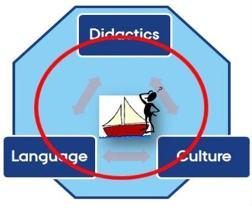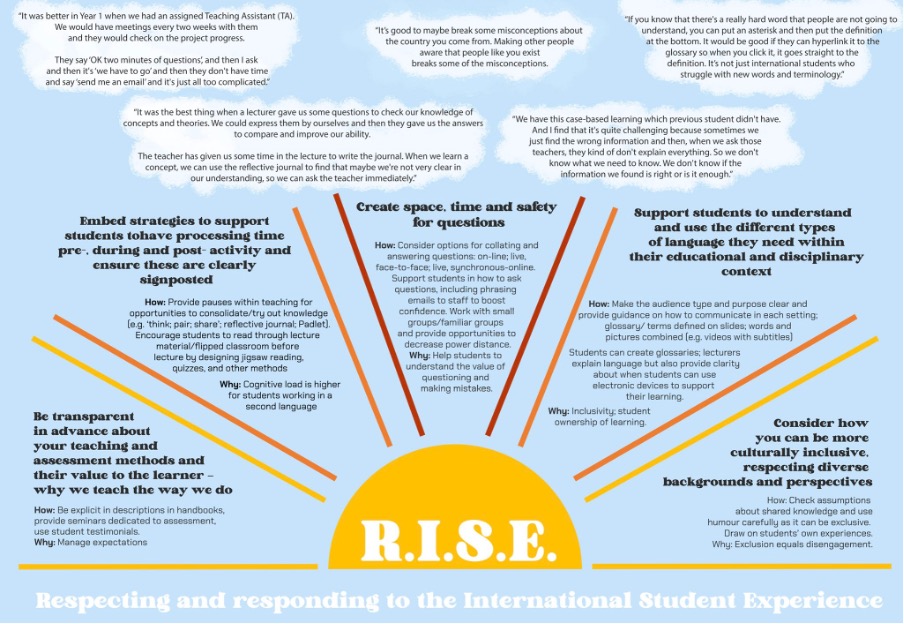Teaching international students
In 2023/24, BILT supported a project researching the experiences of international students. The study led to the creation of the following guidance.
With thanks to researchers: Maxine Gillway, Kevin Haines, Maggie Boswell, Sue Horseman, Catriona Johnson, Maria Tsapali.
We have produced guidance for academics on the design and delivery of their courses for international students in the form of 5 Top Tips. In order to do this, we gathered the perspectives of senior academics and the international students themselves on the way the international students respond to the course design and how they interact with the tasks, their teachers and each other in the learning and teaching processes.
Our starting point was to interview senior academics who are involved in the management, design and delivery of units to students with a diverse range of backgrounds. We used the information that these academics provided to inform observations of teaching and learning practices, as well as focus groups with students, so that we were able to gather both educator and learner perspectives on the same aspects.
Our data collection drew on literature, including a conceptual framework (Lauridsen) that grounded our study and steered our data collection i.e. Lauridsen’s (2015)1 description of the ‘Bermuda Triangle’. This framework was created when educators and students were unable to resolve the complex set of relationships in international classrooms between the didactics or pedagogy, language usage and (inter)cultural influences. These three ‘variables’ provided us with a heuristic foundation for the investigation of the experiences of students in international classrooms across three sites: Bristol Veterinary School, School of Education, Faculty of Science & Engineering.
Data collection took place at the three sites during the period January-April 2024.

What did we find out?
We have produced ‘findings’ as five Top Tips under the RISE banner RESPECTING AND RESPONDING TO THE INTERNATIONAL STUDENT EXPERIENCE, which have been designed into visual formats (with the help of BILT, thanks and acknowledgements to Amy Palmer). Either of the two posters (Version 1 (PDF, 9,253kB) or Version 2 (PDF, 902kB) - same content, different layouts!) may be used for dissemination purposes with lecturers, being displayed in prominent places and allowing for interaction on padlets through QR codes (under construction).
The strength of the RISE project is that it shares practical advice on teaching international students through the voices of those students (the quotes). The focus on How to follow the Tips and the purpose of doing so (the Why) encourages lecturers to make adjustments to their teaching practices to better align with the experiences of those students. Read all of the Top Tips below.
Create space, time and safety for questions
- How: Consider options for collating and answering questions: on-line; live, face-to-face; live, synchronous-online. Support students in how to ask questions, including phrasing emails to staff to boost confidence. Work with small groups/familiar groups and provide opportunities to decrease power distance.
- Why: Help students to understand the value of questioning and making mistakes.
- Student quote:
"It was better in Year 1 when we had an assigned Teaching Assistant (TA). We would have meetings every two weeks with them and they would check on the project progress.
They say ‘OK two minutes of questions’, and then I ask and then it's ‘we have to go’ and then they don't have time and it's just too complicated."
Consider how you can be more culturally inclusive, respecting diverse backgrounds and perspectives
- How: Check assumptions about shared knowledge and use humour carefully as it can be exclusive. Draw on students’ own experiences.
- Why: Exclusion equals disengagement.
- Student quote:
"It’s good to break some misconceptions about the country you come from. Making other people aware that people like you exist breaks some of the misconceptions."
Support students to understand and use the different types of language they need within their contexts
- How: Make the audience type and purpose clear and provide guidance on how to communicate in each setting; glossary/ terms defined on slides; words and pictures combined (e.g. videos with subtitles)Students can create glossaries; lecturers explain language but also provide clarity about when students can use electronic devices to support their learning.
- Why: Inclusivity; student ownership of learning.
- Student quote:
"If you know that there's a really hard word that people are not going to understand, you can put an asterisk and then put the definition at the bottom. It would be good if they can hyperlink it to the glossary so when you click it, it goes straight to the definition. It’s not just international students who struggle with new words and terminology..."
Embed strategies to support students to have processing time, and ensure these are clearly signposted.
Full title: Embed strategies to support students to have processing time pre-, during and post- activity, and ensure these are clearly signposted
- How: Provide pauses within teaching for opportunities to consolidate/try out knowledge (e.g. ‘think; pair; share’; reflective journal; Padlet).Encourage students to read through lecture material/flipped classroom before lecture by designing jigsaw reading, quizzes, and other methods
- Why: Cognitive load is higher for students working in a second language
- Student quotes:
"It was the best thing when a lecturer gave us some questions to check our knowledge of concepts and theories. We could express them by ourselves and then they gave us the answers to compare and improve our ability."
"The teacher has given us some time in the lecture to write the journal. When we learn a concept, we can use the reflective journal to find that maybe we're not very clear in our understanding, so we can ask the teacher immediately."
Be transparent in advance about your teaching and assessment methods and their value to the learner
Full title: Be transparent in advance about your teaching and assessment methods and their value to the learner – why we teach the way we do
- How: Be explicit in descriptions in handbooks, provide seminars dedicated to assessment, use student testimonials.
- Why: Manage expectations
- Student quote:
"We have this case-based learning which previous students didn't have.And I find that it's quite challenging because sometimes we just find the wrong information and then, when we ask those teachers, they don't explain everything. So we don't know what we need to know. We don't know if the information we found is right or is it enough."
What was the impact?
The projected impact, as described above, is that the displayed posters will lead to rethinking, adjustment and dialogue between lecturers over the coming year. The impact will depend on the prominence given to the posters both physically and in terms of dialogue through CPD events etc. both ‘locally’ within Schools and at institutional level (through BILT, CREATE workshops and other mechanisms).

Next steps for this project
The RISE posters will be shared prominently across the university, including QR links to allow responses from lecturers into padlets. Furthermore, the RISE content will be embedded in CPD activity and other forms of dialogue between lecturers, an example being the BILT HEA CREATE scheme workshop on Learning & Teaching in the International Classroom.
Contact
Maxine Gillway: Maxine.gillway@bristol.ac.uk
Kevin Haines: Kevin.Haines@bristol.ac.uk